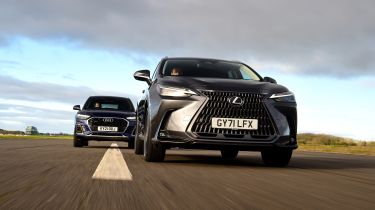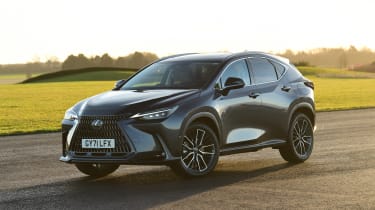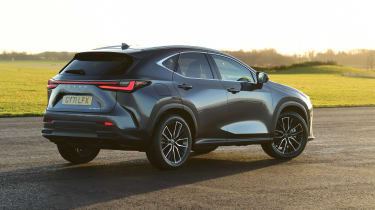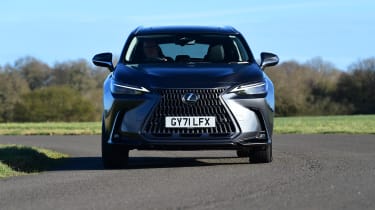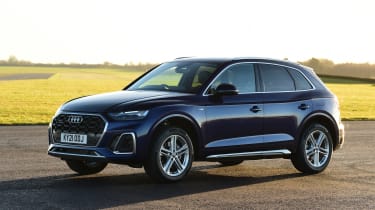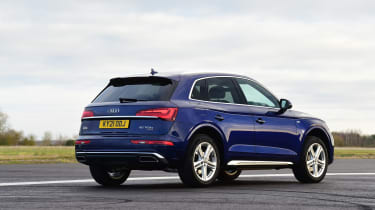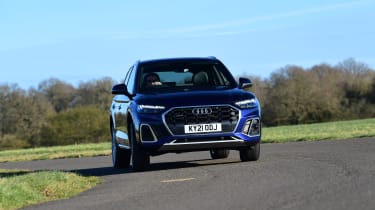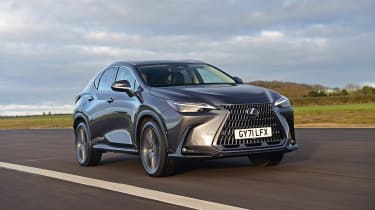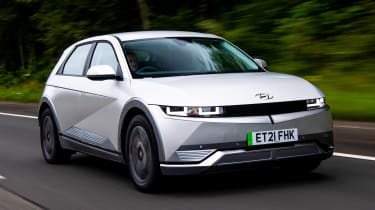Lexus NX 450h+ vs Audi Q5 50 TFSI e: 2022 twin test review
The Lexus NX 450h+ is the company’s first plug-in model. How does it compare against the Audi Q5 TFSI e?
If there’s one premium brand that knows its way around hybrid drive systems better than any other, it’s Lexus. The company has championed the mix of combustion and electric power since the RX 400h was released back in 2005; it believed in the tech so much that it only fleetingly tried diesel at a time when every other brand saw it as the direction for low emissions.
It’s maybe a little odd, then, that it’s taken until now for Lexus to produce its first plug-in hybrid. It comes in the form of the second-generation NX SUV, a car which has a wealth of petrol-electric competitors to face up against.
And it’s against tough competition here. In any of its forms, the Audi Q5 is a top-tier contender in the posh mid-size SUV class, and as the 50 TFSI e model, it offers the potential for lower running costs than any other variant in the range.
Having sampled the NX in conventional hybrid form and discovering it’s one of Lexus’s most convincing models yet, now the plug-in hybrid 450h+ will show us what it’s capable of.
Lexus NX
|
Model: |
Lexus NX 450h+ Takumi |
|
Price: |
£59,700 |
|
Engine: |
2.5-litre 4cyl plus 2 e-motors, 305bhp |
|
0-62mph: |
6.3 seconds |
|
Economy: |
48.9mpg/10.8mpl |
|
CO2: |
20-26g/km |
|
Annual road tax: |
£480 |
THE NX 450h+ here is tested in top-spec Takumi trim. The only extra is Sonic Grey paint, which adds £920 to the on-the-road price of £59,700.
Design & engineering
The second-generation NX certainly sports a similar angular shape to its predecessor on the outside, but the changes to this model extend well beyond a fancy new LED light bar that spans the tailgate.
Used - available now

2023 Kia
Niro EV
19,909 milesAutomaticElectric
Cash £18,600
2021 Ford
Focus Estate
58,077 milesManualPetrol1.0L
Cash £11,700
2024 BMW
M135i
31,851 milesAutomaticPetrol2.0L
Cash £24,500
2021 Mercedes
A-Class
35,083 milesAutomaticPetrol1.3L
Cash £18,400That’s because this version now sits on Toyota’s TNGA-K platform, which is closely related to the underpinnings of the Toyota RAV4. Much like that SUV, one of the key benefits has been the ability to install a plug-in hybrid powertrain. The set-up here features a 183bhp 2.5-litre four-cylinder petrol engine combined with two electric motors. There’s one up front with the engine that matches its 183bhp output and has 270Nm of torque, while the one at the back is more modest, with 53bhp and 121Nm. These three power sources don’t all produce their maximum at the same time, so Lexus quotes a total system output of 305bhp.
The NX is still available as a conventional hybrid as before. This model has a total system output of 241bhp, and it’s available with a choice of either front-wheel drive or, for £1,000 extra, four-wheel drive. The latter features the same electric motor-driven rear axle as the plug-in model, so there’s no physical connection between the front and rear axles. Lexus has always managed to excel when it comes to cabin quality, and the NX features a smartly appointed interior. There’s an all-new layout, made necessary by the huge touchscreen that dominates the dashboard.
Driving
Since the Lexus has a more powerful electric motor than the Audi, it will be no surprise to learn that the NX feels the more sprightly and torquey of the cars when driving in zero-emissions mode. If there’s enough charge in the battery, the system defaults into a full-electric setting; like this, there’s more than enough power to keep up with traffic right up to motorway speeds. Even if you mash the accelerator, it won’t switch on the petrol engine.
To access the NX’s full performance, you need to prod the hybrid button, at which point the 2.5-litre engine will help out when needed. It engages almost seamlessly, and while there’s a short delay for it to fully come on song under hard acceleration, the electric drive manages to cover off most of that pause. The NX feels every bit as quick as its 6.3-second 0-62mph time suggests, although at higher speeds the rate of acceleration tails off a little more than you might expect from a 305bhp output.
One frequent criticism we’ve had of the NX’s E-CVT transmission in the past is that the engine can drone when full power is required. While that still applies here, it matters far less; the electrical systems are able to provide so much power that such noises rarely occur. For the most part, the engine just hums quietly away in the background. The NX handles a little more sharply than the Audi, although while the ride is comfortable for the most part, there’s a subtle underlying fidget from the suspension, which means that the Q5 just holds the edge in terms of comfort.
Practicality
In terms of overall boot capacity, the NX has the Q5 beaten whether the seats are up or down. The 525-litre load bay has some neat touches, too; the underfloor storage space, for example, is easily big enough to hold both the Type 2 and three-pin charging cables that come with the car – something that isn’t possible in the Q5.
But while the Lexus is larger overall, the Audi’s load bay is better shaped. The NX has quite a high boot floor, and when the back seats are folded flat, it leaves a big step, which makes it a little tricky to push larger items all the way through. With the rear bench dropped, there’s 1,436 litres of space – a nominal 31 litres more than you get in the Q5.
Parking can be a tricky task in such large SUVs, but higher-spec versions of the NX come with a system called a Panoramic View Monitor. Much like Land Rover’s Clearsight system, it projects an image of what’s in close proximity to the car via the main display. This makes it very easy to position the wheels close to kerbs and avoid other obstacles.
Ownership
Lexus has a long-standing reputation for providing customers with a great ownership experience, and our latest Driver Power satisfaction survey confirmed this once again.
As a manufacturer, Lexus took 10th place overall of 29 brands, but the key stat is that fewer than 10 per cent of owners experienced faults with their vehicles, making Lexus one of the most reliable brands in the survey. In the unlikely event that something does go wrong, Lexus provides up to 10 years of warranty cover; the only catch being that the car must be serviced by a main dealer for that entire period.
Its dealers scored extremely well in Driver Power, too, finishing second only to Porsche out of 21 networks. In contrast, Audi fared poorly, with its range taking 23rd and its dealers finishing a lowly 18th.
Running costs
If you only cover short journeys, then regular battery charges will help both of these cars to be incredibly cheap to run. However, drive further on petrol power more often, and there’s a big difference between the two.
Once these two run low on battery charge, the Lexus is a much more efficient hybrid than the Audi. As a result the NX will average in the mid-40s for fuel economy, while the Q5 will struggle to get to 35mpg. That’s the difference between a fuel bill of £2,724 per 20,000 miles for the Lexus, and paying £1,115 more than that for the Audi over the same distance.
Audi Q5
|
Model: |
Audi Q5 50 TFSI e Quattro S Line |
|
Price: |
£54,300 |
|
Engine: |
2.0-litre 4cyl turbo plus e-motor, 295bhp |
|
0-62mph: |
6.1 seconds |
|
Economy: |
34.7mpg/7.6mpl |
|
CO2: |
35g/km |
|
Annual road tax: |
£480 |
The Audi Q5 TFSI e is offered in six trim levels which, as we’ll see later, offer a wide range of pricing options. Here we have the S line model, which comes to £54,300 before options.
Design & engineering
While both of these cars have petrol-electric drive systems, the focus of the hybrid tech has a very different bias. As we’ve seen, the Lexus gets most of its power from the electrical elements, while the Audi uses its petrol engine for the majority of its shove.
The 2.0-litre turbocharged unit makes 261bhp and 370Nm of torque – far more than the 183bhp and 227Nm that the NX 450h’s combustion unit musters. However, the Audi’s electrical element is weaker; it only has 141bhp, and the overall power output of the Q5 50TFSI e is 10bhp down on the Lexus’s, at 295bhp.
The Audi’s 17.9kWh battery is claimed to return 37 miles of range according to the official WLTP figures. That’s six miles fewer than its rival, despite the fact that the NX’s battery is only slightly larger, at 18.1kWh.
Step inside, and the Audi’s level of finish is mostly impressive. Much of the switchgear operates with a more satisfying feel than the buttons in the NX, but then other touch points, such as the door grab handles, are finished in cheap-feeling hard plastic. Beside both the Lexus and some other rivals, the Q5’s design is starting to look a little dated, too.
High-end Vorsprung models are equipped with a sophisticated air suspension system, but the rest of the Q5 range, including our test car, uses a simpler steel spring arrangement with adaptive dampers.
Driving
Even with this more conventional suspension layout, the Audi still proves to feel marginally more compliant than the Lexus. There’s not much to separate the pair for overall ride comfort, but the Audi is slightly softer when hitting a bump, and is quicker to settle after it, too. It doesn’t translate into a sharp-handling car, though; the Q5 feels heavy through the corners compared with the Lexus, although it does have plenty of grip.
The power deficiency in the Audi’s electrical system means that it can’t run in full EV mode as often as the NX, and the engine fires up to help out more frequently. The transition between electric and petrol modes is jerkier, especially under hard acceleration, but the Audi is slightly quicker, beating the NX 450h+ from 0-62mph by two tenths of a second, with a time of 6.1 seconds.
The engine isn’t particularly tuneful when stretched, but it’s smoother than the Lexus’s larger unit, and the shifting of the Audi’s eight-speed automatic feels much more natural. If you choose to drive more keenly, the steering wheel-mounted paddles allow for manual control, and the gearbox responds crisply.
It’s at higher speeds where the Audi has an edge. The extra power from the petrol engine means that it feels more punchy the quicker you travel (highlighted by its 148mph top speed, which is 24mph faster than the Lexus’s), but more significant is the Q5’s stability at motorway speeds, which is superb. There’s little to separate the two when it comes to road and wind noise; both remain very hushed and isolate their occupants well.
Practicality
While the Lexus has a marginally better boot, the Audi has the edge for carrying passengers. That’s not to say that the NX is tight, it’s just that kneeroom in the Q5 is much more generous, and headroom is great, too.
The floor feels lower in the back than in the Lexus; not only does that mean there’s more foot space under the front seats, but occupants with longer legs also get better under-thigh support from the seat squabs. The one downside comes with the central seat; the backrest (the part which doubles as a fold-out armrest) is hard, and there’s also a large central hump in the floor. In contrast, the centre seat in the NX is much more supportive and the floor hump is lower.
There’s only one 12-volt socket in the back of the Q5; the Lexus also has a pair of USB-C ports. Isofix points are very easy to access behind plastic covers, though, and there are further mounts on the front passenger seat. Deep door bins, a large glovebox and a small slot for the Audi’s key are neat ideas up front, but there are also a couple of fairly useless small cubbies, which are good for storing little more than loose change.
Ownership
The Q5 was tested by Euro NCAP in 2017, when it scored a maximum five- star rating, with a particularly impressive 93 per cent score for adult occupant protection.
All Q5s are equipped with a pop-up bonnet to reduce the risk of injury to pedestrians, plus at least six airbags and an autonomous emergency braking system that can avoid or mitigate collisions from below 52mph. Reversing bumps should be fairly unlikely, thanks to a standard-fit rear-facing camera, but the images aren’t as sharp as the 360-degree set-up used by the Lexus.
The latest NX is too new to have been rated by Euro NCAP yet, but every Lexus tested since 2005 has achieved five stars to the standards of the time, including this car’s predecessor back in 2014.
Running costs
While plug-in hybrids aren’t quite as affordable for company car users as fully electric vehicles, their low emissions mean that they manage to slip into low Benefit-in-Kind brackets. Categories are based on emissions and the distance that can be covered on electric power alone.
Because the NX officially travels six miles further than the Q5, it sits in the seven per cent bracket, compared with the Audi’s 11 per cent group. That means a higher-rate income taxpayer would face deductions of £2,418 for the Audi, which is £706 more than Lexus drivers will have to face.
Verdict
First Place: Lexus NX
The main benefits of plug-in hybrids are lower fuel and tax costs. On both counts the NX is the superior car here. Its efficiency advantage over the Audi only grows larger when the battery is depleted, too. Factor in excellent refinement and quality, plus Lexus turning what was once a big negative – its infotainment tech – into one of the NX’s best points, and it’s a deserved winner.
Second place: Audi Q5
Despite the second-place finish, there’s still plenty to admire about the Audi. It’s a little more comfortable than the Lexus, and the petrol engine gives stronger performance out of town. However, it feels more sluggish in electric mode, and is much thirstier as a hybrid. The Lexus feels like the fresher, more modern SUV, which is why the Audi is our runner-up.
Also consider…
Hyundai Ioniq 5 Ultimate
- Price: £47,890
- Powertrain: 73kWh battery, 301bhp
If you’re ready to make the jump to a full EV, then it’s hard to see what these cars offer that the Ioniq 5 lacks. The Hyundai is quicker than both, roomier inside, and even in its poshest trim is over £6,000 cheaper than the Audi.
Figures
|
Lexus NX 450h+ Takumi |
Audi Q5 S line 50 TFSI e quattro | |
|
On the road price/total as tested |
£59,700/£60,620 |
£54,300/£54,975 |
|
Residual value (after 3yrs/36,000) |
£29,623/49.6% |
£27,660/50.9% |
|
Depreciation |
£30,077 |
£26,640 |
|
Annual tax liability std/higher rate |
£856/£1,712 |
£1,209/£2,418 |
|
Annual fuel cost (12k/20k miles) |
£1,634/£2,724 |
£2,303/£3,839 |
|
Insurance group/quote/VED |
41/£758/£480 |
43/£775/£480 |
|
Cost of 1st/2nd/3rd service |
£760 (2yrs) |
£529 (2yrs) |
|
Length/wheelbase |
4,660/2,690mm |
4,682/2,819mm |
|
Height/width |
1,670/1,865mm |
1,662/1,893mm |
|
Powertrain |
4cyl in-line/2,487cc |
4cyl in-line/1,984cc |
|
Total system power |
305bhp |
295bhp |
|
Total system torque |
291Nm |
370 Nm |
|
Electric motor power/torque |
236/391 bhp/Nm* |
141/350 bhp/Nm |
|
Battery size |
18.1kWh |
17.9kWh |
|
Transmission |
E-CVT auto/4wd |
8-spd auto/4wd |
|
Fuel tank capacity/spare wheel |
55 litres/run flats |
54 litres/repair kit |
|
Boot capacity (seats up/down) |
525/1,436 litres |
465/1,405 litres |
|
Kerbweight/payload/towing weight |
1,990/550/1,500kg |
2,075/585/2,000kg |
|
Turning circle |
12.4 metres |
11.8 metres |
|
Basic warranty (miles)/recovery |
10yrs (100k)/3yrs |
3yrs (60k)/3yrs |
|
Driver Power manufacturer/dealer pos |
10th/2nd |
23rd/18th |
|
NCAP: Adult/child/ped./assist/stars |
N/A |
93/86/73/58/5 (’17) |
|
0-62mph/top speed |
6.3 secs/124mph |
6.1 secs/148mph |
|
Auto Express economy (mpg/mpl) |
48.9/10.8 |
34.7/7.6 |
|
WLTP combined |
256.8-313.9mpg |
176.6mpg |
|
WLTP combined |
56.5-69mpl |
38.8mpl |
|
Claimed EV range |
43 miles |
37 miles |
|
Charge time (7.4kW source) |
2h 45min |
2h 30min |
|
Actual/claimed CO2/tax bracket |
133/20-26g/km/7% |
188/35g/km/11% |
|
Airbags/Isofix/park sensors/camera |
Yes/yes/f&r/360o |
Yes/yes/f&r/yes |
|
Auto box/lane keep/blindspot/AEB |
Yes/yes/yes/yes |
Yes/no/no/yes |
|
Climate control/adaptive cruise |
Yes/yes |
Yes/no |
|
Leather/heated seats |
Yes/yes |
Part/yes |
|
Met paint/LEDs/keyless/pwr tailgate |
£670/yes/yes/yes |
£675/yes/yes/yes |
|
Sat-nav/digi dash/DAB/connectivity |
Yes/yes/yes/yes |
Yes/yes/yes/yes |
|
Wireless charge/CarPlay/Android Auto |
Yes/yes/yes |
No/yes/yes |
